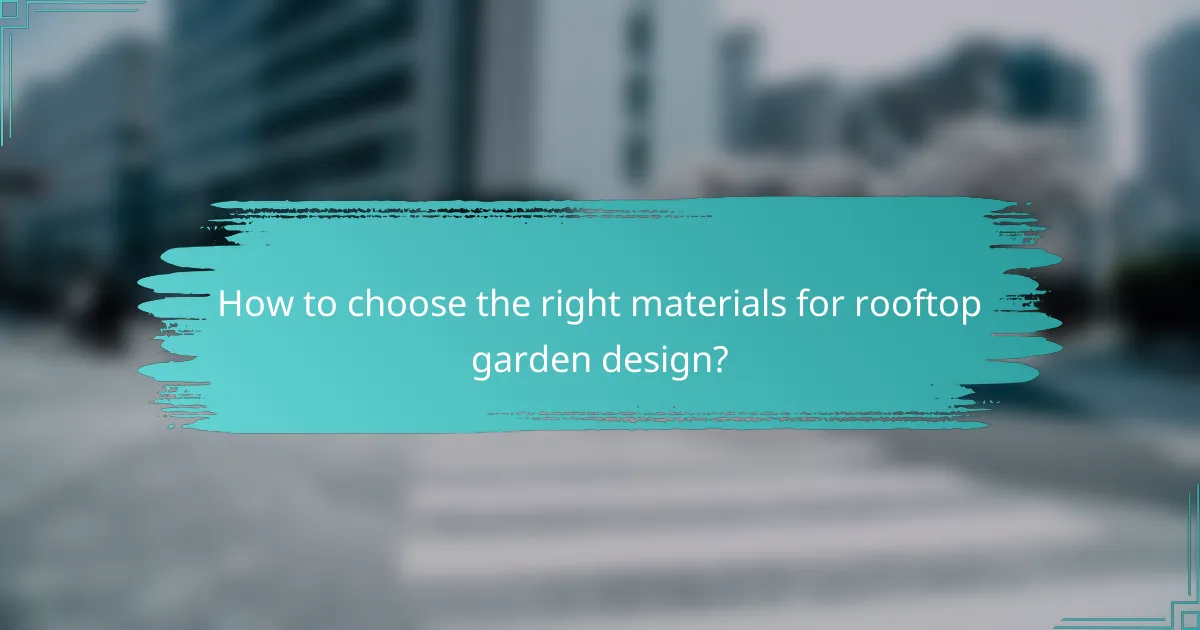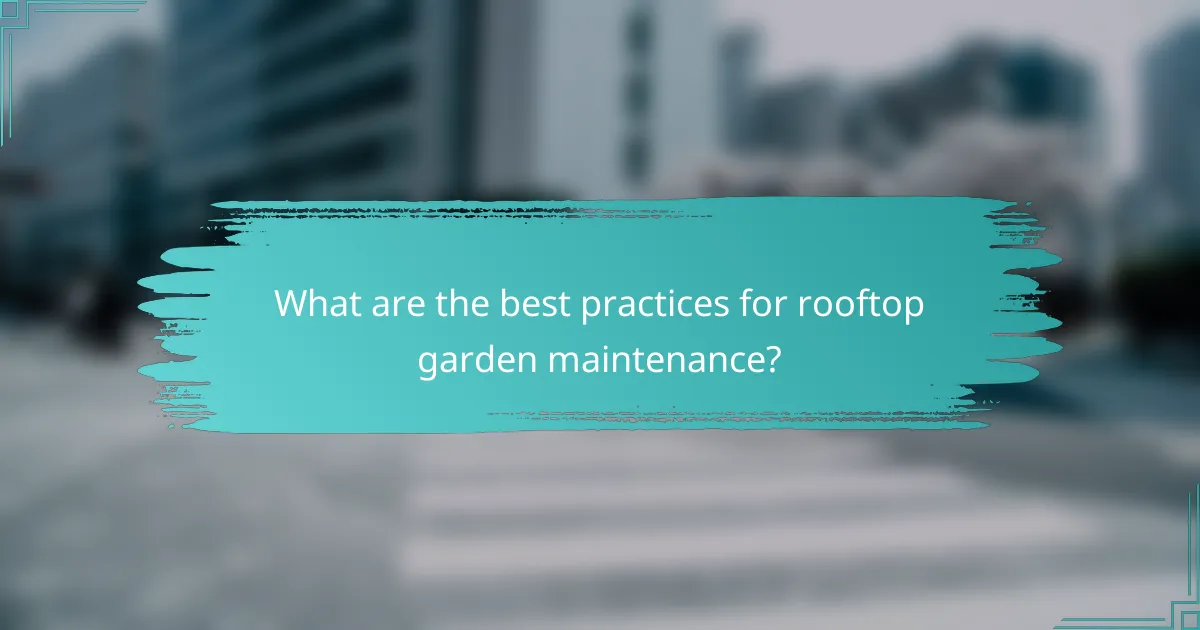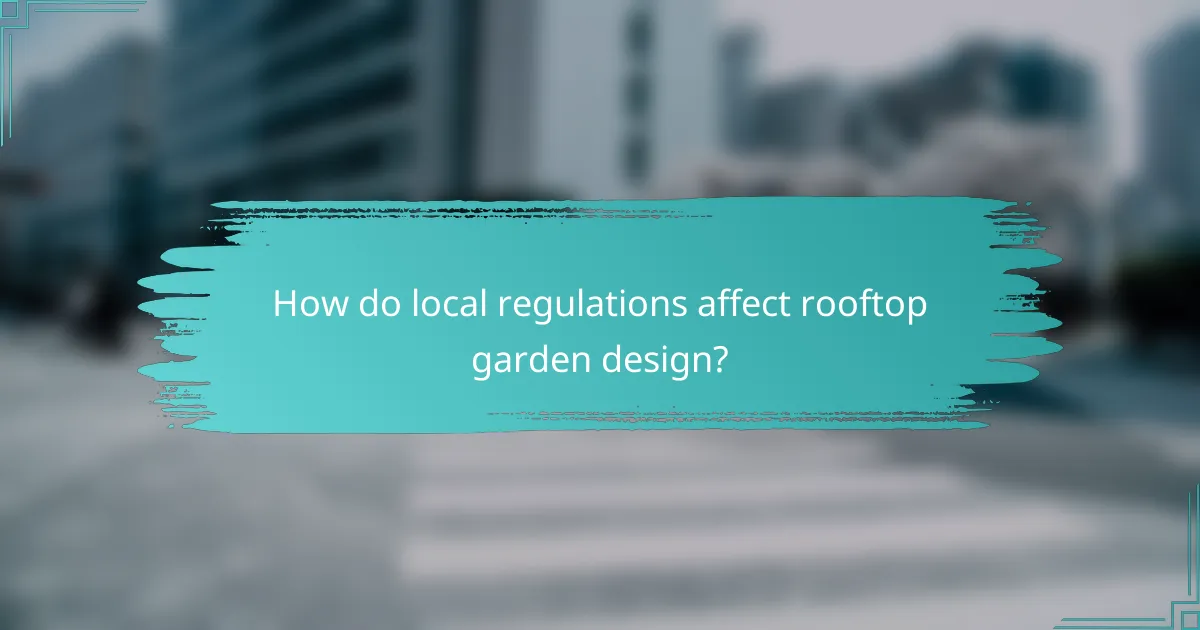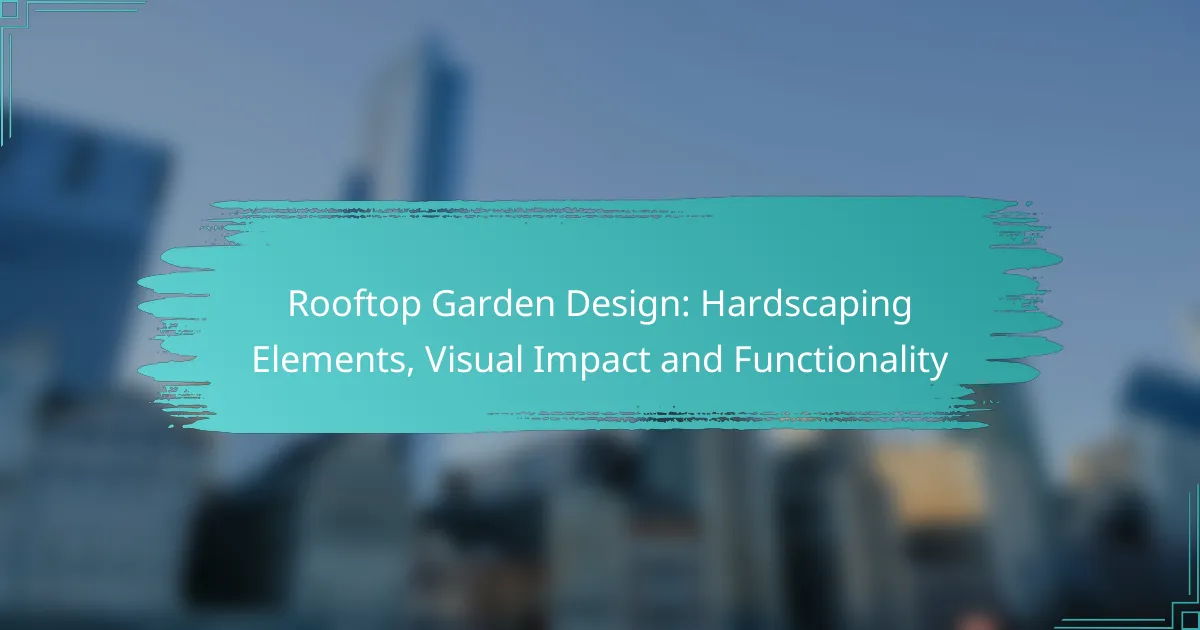Rooftop garden design integrates hardscaping elements that enhance both functionality and visual appeal, creating a harmonious outdoor space. Key features such as pathways, patios, and walls not only provide structure and organization but also improve drainage and support for plants. By thoughtfully incorporating these elements, rooftop gardens can offer significant benefits, including better stormwater management and increased recreational areas, ultimately contributing to urban sustainability and residents’ quality of life.

What are the key hardscaping elements for rooftop gardens?
Key hardscaping elements for rooftop gardens include materials and structures that provide both functionality and aesthetic appeal. These elements are essential for creating a usable and visually pleasing outdoor space while ensuring proper drainage and support.
Pavers and decking materials
Pavers and decking materials are crucial for establishing the foundation of a rooftop garden. Options such as concrete pavers, wood decking, or composite materials can enhance the visual appeal while providing durability. Consider materials that are lightweight and weather-resistant to withstand rooftop conditions.
When selecting pavers or decking, ensure they have proper slip resistance and can handle the weight load of the garden. A common choice is interlocking pavers, which allow for easy installation and maintenance.
Retaining walls and planters
Retaining walls and planters serve both functional and aesthetic purposes in rooftop gardens. They help manage soil and plant placement while adding vertical interest to the space. Materials like stone, brick, or treated wood are popular for creating these structures.
When designing retaining walls, consider their height and the potential for soil erosion. Planters should be designed with drainage in mind, using materials that prevent water accumulation and promote healthy plant growth.
Water features and drainage systems
Water features, such as fountains or ponds, can enhance the tranquility of a rooftop garden while providing a cooling effect. However, proper drainage systems are essential to prevent water buildup, which can damage the structure. Incorporate drainage solutions like perforated pipes or gravel beds to manage excess water effectively.
Ensure that any water feature is lightweight and designed for rooftop use. Regular maintenance is necessary to keep water features clean and functional, preventing algae growth and blockages.
Lighting solutions for ambiance
Lighting solutions are vital for creating ambiance in rooftop gardens, allowing for enjoyment during the evening. Options include LED string lights, solar-powered lanterns, or recessed lighting in pathways. Choose fixtures that are weatherproof and energy-efficient to reduce long-term costs.
Consider the layout and placement of lights to highlight key features, such as plants or seating areas. Dimmer switches can also enhance the flexibility of the lighting, allowing for different moods and occasions.
Furniture and seating arrangements
Furniture and seating arrangements are essential for making rooftop gardens comfortable and inviting. Opt for weather-resistant materials like aluminum, teak, or synthetic wicker that can withstand outdoor conditions. Arrange seating to encourage conversation and relaxation, maximizing the use of space.
Consider multifunctional furniture, such as benches with storage or tables that can be adjusted for size. Ensure that there is enough space for movement and that the layout complements the overall design of the garden.

How do hardscaping elements impact visual design?
Hardscaping elements significantly influence the visual design of a rooftop garden by providing structure, contrast, and a sense of organization. These features, which include pathways, patios, walls, and other non-plant materials, can enhance the aesthetic appeal and functionality of the space.
Color and texture contrast
Color and texture contrast in hardscaping can create visual interest and depth in a rooftop garden. For instance, pairing smooth stone pavers with rough wooden decking can enhance the overall design by drawing attention to different areas. Selecting materials in complementary colors can also help unify the space while allowing for distinct zones.
When choosing colors, consider the surrounding environment and the mood you want to create. Light-colored materials can brighten a space, while darker tones may provide a more intimate feel. Aim for a balance that reflects your personal style and the garden’s purpose.
Spatial organization and flow
Effective spatial organization is crucial for ensuring a smooth flow in a rooftop garden. Hardscaping elements like pathways and seating areas should guide visitors through the space, making it inviting and functional. Consider using materials that delineate different areas, such as gravel for walkways and tiles for dining spaces.
To enhance flow, avoid cluttering the area with too many hardscaping features. Instead, focus on a few key elements that serve specific purposes, allowing for easy navigation and a clear visual path. This approach can create a more enjoyable experience for users.
Integration with plant life
Integrating hardscaping elements with plant life is essential for creating a cohesive rooftop garden. The right combination can enhance both aesthetics and functionality. For example, raised planters can serve as seating while providing a backdrop for vibrant flowers or greenery.
When planning integration, consider the growth habits of plants and their compatibility with hardscape materials. Ensure that hardscaping does not obstruct sunlight or water access to plants. Using permeable materials can also help manage drainage and promote healthy plant growth.

What functional benefits do rooftop gardens provide?
Rooftop gardens offer numerous functional benefits, including improved stormwater management, enhanced thermal insulation, and valuable outdoor recreation space. These gardens can significantly contribute to urban sustainability and enhance the quality of life for residents.
Stormwater management
Rooftop gardens play a crucial role in stormwater management by absorbing rainwater, which reduces runoff and minimizes the risk of flooding. This absorption helps to filter pollutants, improving water quality before it reaches drainage systems.
To maximize stormwater benefits, consider using a variety of plants with deep root systems that can retain more water. Additionally, incorporating permeable materials in hardscaping can further enhance water absorption and drainage.
Thermal insulation and energy efficiency
Rooftop gardens provide thermal insulation, helping to regulate building temperatures. By absorbing sunlight and reducing heat absorption by the building, these gardens can lower air conditioning costs during hot months and heating costs in colder seasons.
Research indicates that green roofs can reduce indoor temperatures by several degrees, leading to energy savings of up to 20%. When designing a rooftop garden, consider the selection of plants that thrive in your local climate to maximize these energy efficiency benefits.
Outdoor recreation and relaxation space
Rooftop gardens create valuable outdoor spaces for recreation and relaxation, offering a unique escape from urban environments. These areas can be designed for various activities, such as gardening, lounging, or social gatherings.
When planning a rooftop garden for leisure, include comfortable seating, shade structures, and pathways for easy movement. Ensure that the design adheres to local building codes and weight limits to maintain safety and functionality.

How to choose the right materials for rooftop garden design?
Selecting the right materials for rooftop garden design involves considering durability, weight, and aesthetic compatibility. These factors ensure that the garden is not only visually appealing but also functional and safe for the building structure.
Durability and weather resistance
Durability is crucial for rooftop gardens, as materials must withstand harsh weather conditions, including rain, wind, and UV exposure. Opt for materials like treated wood, stone, or composite decking that offer longevity and resistance to decay.
Additionally, consider using weather-resistant fabrics for furniture and planters. Fabrics made from synthetic fibers are often more resilient against fading and moisture than natural materials.
Weight considerations for structural integrity
Weight is a critical factor in rooftop garden design, as the structural integrity of the building must be maintained. Lightweight materials, such as aluminum planters and lightweight soil mixes, can help reduce the overall load on the roof.
Before installation, consult with a structural engineer to assess the load-bearing capacity of the roof. This ensures that the chosen materials do not exceed safe weight limits, which typically range from 15 to 25 pounds per square foot.
Aesthetic compatibility with surroundings
Aesthetic compatibility ensures that the rooftop garden complements the existing architecture and landscape. Choose materials that harmonize with the building’s style, such as modern metals for contemporary designs or natural stone for traditional aesthetics.
Incorporating colors and textures that reflect the surrounding environment can enhance visual appeal. For example, using earthy tones can create a seamless transition between the garden and the urban landscape.

What are the best practices for rooftop garden maintenance?
Effective rooftop garden maintenance involves regular inspections, seasonal planting, and efficient watering management. These practices ensure the longevity and health of both plants and hardscaping elements.
Regular inspection of hardscaping
Conducting regular inspections of hardscaping elements is crucial for identifying wear and tear, structural issues, or drainage problems. Check for cracks in paving, loose stones, or any signs of erosion that could affect the garden’s functionality.
Inspecting hardscaping should be done at least twice a year, ideally in spring and fall. Look for any debris accumulation that could hinder drainage and remove it promptly to prevent water pooling.
Seasonal planting and pruning
Seasonal planting and pruning are essential for maintaining a vibrant rooftop garden. Choose plants that thrive in your local climate and consider rotating them based on seasonal changes to ensure continuous blooms and foliage.
Pruning should be done regularly to promote healthy growth and remove dead or diseased branches. Aim to prune flowering plants right after they bloom to encourage new growth for the next season.
Watering and irrigation management
Effective watering and irrigation management are vital to prevent overwatering or underwatering, both of which can harm rooftop plants. Implement a drip irrigation system for efficient water delivery, especially in hot months.
Monitor soil moisture levels regularly, aiming for a balance that keeps the soil damp but not saturated. Adjust your watering schedule based on rainfall and seasonal temperature changes, ensuring plants receive adequate hydration without excess water.

How do local regulations affect rooftop garden design?
Local regulations significantly impact rooftop garden design by dictating what is permissible in terms of structure, aesthetics, and safety. Understanding these regulations is crucial for ensuring compliance and maximizing the garden’s potential.
Zoning laws and building codes
Zoning laws and building codes establish the legal framework for rooftop gardens, influencing aspects such as height restrictions, load-bearing capacities, and permitted materials. For instance, some areas may require a structural engineer’s assessment to ensure the rooftop can support the additional weight of soil and plants.
It’s essential to check local zoning regulations, as they can vary widely between municipalities. In urban areas, rooftop gardens may be encouraged for their environmental benefits, while suburban zones might have stricter limitations on building modifications.
Before starting a rooftop garden project, consult your local planning department to obtain the necessary permits and understand any specific requirements that may apply to your property.
